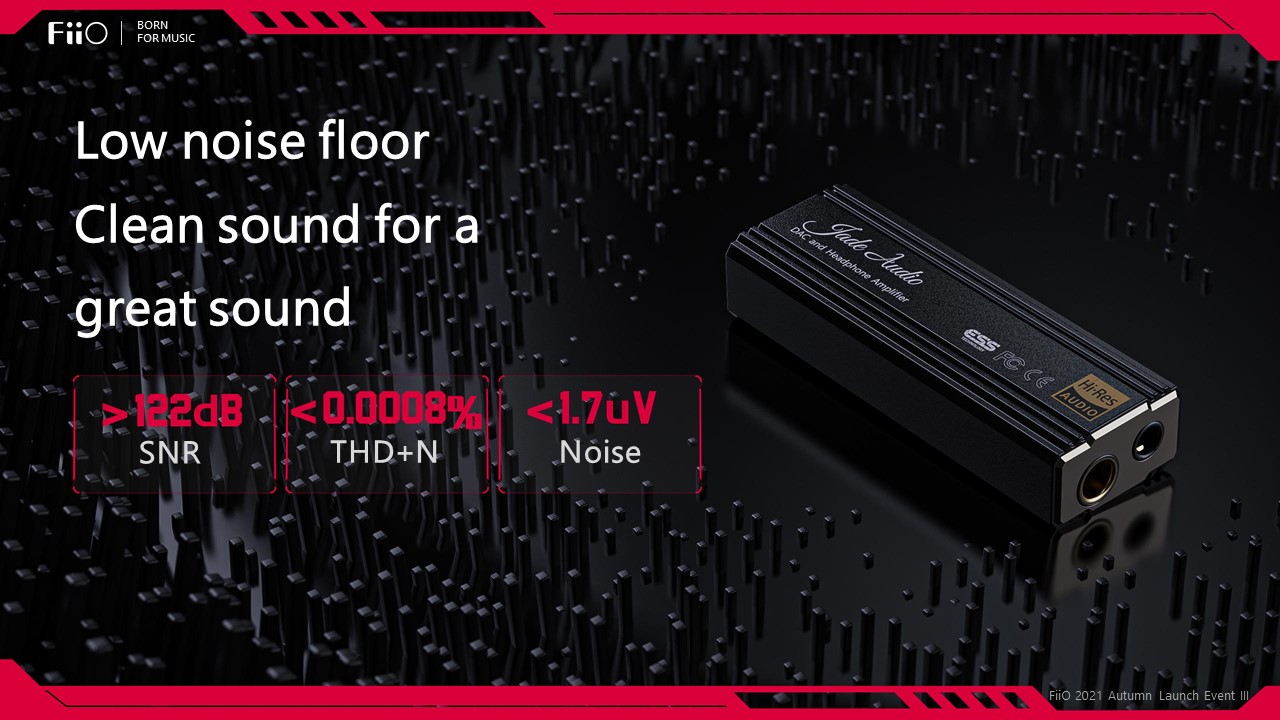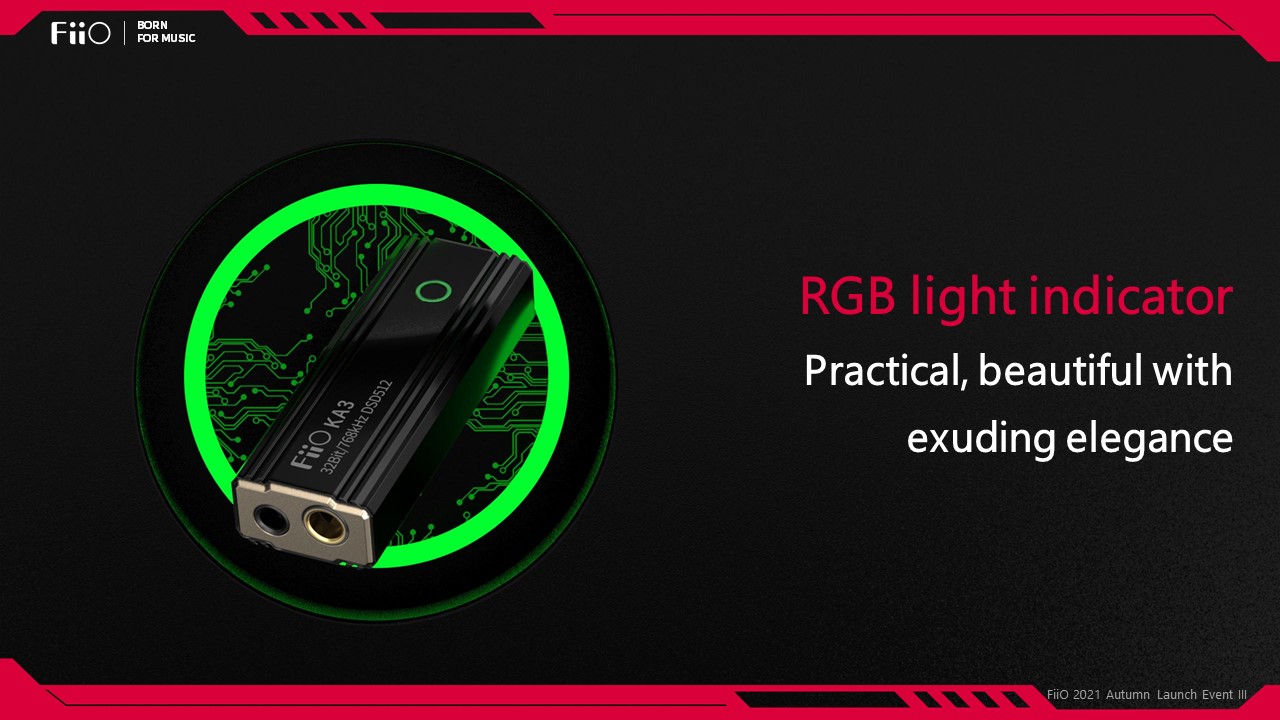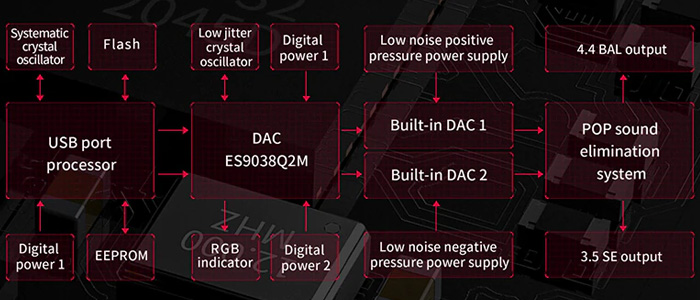The review sample was kindly provided free of charge in exchange for my honest and subjective opinion.
I only covered import fees and tax.
The retail price is €99 and you can buy it using this not affiliate link
FiiO.eu.
Introduction
The FiiO KA3 is the company's first USB DAC/amp dongle to run without an internal battery like the BTR5.
A little late to the party but better late than never.
The KA3 is a co - branding between FiiO and the sister company Jade Audio.
Design and build quality
The KA3 is a DAC/amp dongle featuring a USB type C input with a detachable cable and dual outputs with a single-ended 3.5mm jack and a balanced 4.4mm one.
The provided cable is of good quality with aluminum plugs and strain reliefs at both ends.
A full sized USB adapter is included inside the box.
I always prefer the detachable cable system which may add a little bulk but it is easier to replace a broken cable or use a longer one when it is needed.
The compact unit is made from aluminium alloy and it is quite compact, measuring 56x20x12mm and lightweight, weighing about 17.5g.
It is not the most compact when compared to the competition but the housing is a little larger because it houses some extra electronic components as we are going to discover later on.
Build quality is very good and the unit feels sturdy and durable.
The design is pretty industrial with a ribbon pattern at the edges and a discreet, circular RGB led at the top of the one side.
The LED will flash between yellow, blue and green according to the input sample rate.
48kHz and below is blue, above 48kHz is yellow and green for DSD.
Technology
The chip used to do the decoding is the familiar ES9038Q2M from ESS that is to be found in much more expensive, full sized DACs.
The chip is configured in a dual mono operation for a fully balanced output.
In most USB dongles (especially at this price bracket) the usual practice is to throw the DAC/amp chip inside the case and just add the input and output plugs.
Not here though since FiiO has gone a step further to include some extra electronics, hence the larger body.
There is an extra USB port processor, dual crystal oscillators, independent power supplies with high quality capacitors and two extra op-amps to boost the power output.
The maximum supported sampling rate is 768KHz/32bit PCM and DSD64/128/256/512
Power output
The power output is rated at full scale 4V and 2V under 300Ω load that translates into roughly 240mW/32Ω and 130mW/32Ω from the balanced and the single ended outputs respectively.
Interestingly enough the KA3 is very capable at driving 16Ω loads with a stable power delivery of 120mW from both outputs when most of the competition will hit current limit and enter protection mode.
Connectivity
The KA3 is plug'n play compatible with Android, Windows, Mac and iOS devices although the limited power supply of iPhones may cause it to mute at the higher volume setting.
The user must download the Windows drivers for DSD playback and to separately purchase the lighting cable.
FiiO Control application
The KA3 is compatible with the FiiO control application (only available for Android) that allows for some extra configuration of the unit.
The user can enable or disable the RGB indicator, choose between low and high gain, optimal headphone impedance between low and high, select one of the seven available low pass filters and read the online manual.
Firmware update
After finishing the review, a newer firmware update has been released.
Updated on 2022-01-24
Changes and improvements about new firmware are as follows :
1.Added memory function for turning indicator light off; (You could switch indicator light option between Turn off(until device restart) and Turn off(always) via Android version FiiO Control APP. Turn off(until device restart):Turn off the indicator light for now and turn it on again after the device restarts; Turn off(always): Keep turning off the indicator light until the setting changes.)
2.Added dynamic power policy adjustment function; (With this enabled,the system will dynamically adjust the power policy according to the playback sampling rates,so when playing tracks with lower sampling rates, the power consumption and heat generation will be effectively reduced.
3.Added hardware mute switch function; (The device is embedded with a hardware mute switch, which can mute the impulsive sound that occurs when switching between tracks of different sampling rates. However, when the mute switch functions,it will also make a slight pop sound. You may choose to enable or disable it according to your preference.)
Sound impressions
As per usual practice I left the unit playing music for about 100 hours prior to listening tests.
I have started with entry level iems closer to the selling price of the KA3, like the FiiO FD3 or the DUNU Titan S but later on the high quality of the sound performance made me to switch to much better earphones like the FiiO FD7 and full size headphones like the Sennheiser HD660s rising as far as to the Focal Clear Mg.
Well, this was a spoiler so let me cut straight into the chase, the KA3 is an absolutely stellar performer with a sound quality to match and has become my reference DAC/amp dongle, surpassing much more expensive models like the THX Onyx and the EarMen Sparrow.
Yes it is this good thanks to the perfectly linear frequency response, the crystal clear and dead silent background, the ultimate transparency, the processing precision, the musical presentation and the excellent power delivery.
Super powerful
Speaking of power, the KA3 was no slouch in driving with authority and some headroom left, larger headphones like the Sennheiser HD660s, the Focal Clear Mg or even the power hungry HiFiMan Sundara.
I have never reached above ¾ of the available volume range and I would rank the KA3 as the most powerful and authoritative USB dongle at this size.
Back to the sound
The KA3 has some stellar dynamics with highly convincing swings between rise and fall, done with a desktop-like manner.
With great power reserves, it always sounded surprisingly effortless and muscular for such a small USB powered device.
The bass is deep, full bodied and weighty, yet controlled, tight, clear, precise and perfectly layered.
Sound is fast and agile, with great decaying characteristics.
Midrange is neutral with well sculptured notes, finely articulated voices and a colorful instrumental sound palette.
Timbre is mostly natural sans a few spots of digital glare in the higher registers but still the KA3 is quite coherent and homogeneous with a convincing tone colour that is never too artificial.
No matter the music and the headphone used, it always sounded musical and highly engaging.
Treble is full of energy, sparkling and detailed but not analytical, precise and extended but not bright or harsh.
Of course you should always remember that the KA3 is extremely transparent and precise so it will present your music with ruthless honesty so bad recordings will sound bad and vice versa.
The same principle applies to earphone matching, the KA3 will not impart its own character and the sound signature will be mostly determined by the earphone itself.
With all the headphones used, I liked the soundstage capabilities of this little DAC a lot.
Sound was always open and spacious, mostly extended in the width rather than the depth although not absent of some layering and imaging was precise and correct.
I didn't miss a lot and I remained very satisfied with the holography of the imaginary soundscape.
The new reference
After some extensive music listening, using various earphones and headphones I ended in preferring the KA3 over my previous references, the THX Onyx, the EarMen Sparrow and the Violectric Chronos, that all of them cost double the money over the KA3.
Vs THX Onyx
The THX Onyx is as good as it gets from its single ended output but it gets surpassed by the balanced output of the KA3.
Sound is quite close but I found the KA3 to be more muscular, slightly more musical and open sounding without sacrificing in transparency.
Still the THX Onyx ranks among the best single ended USB DAC dongles with a slightly different form factor and MQA decoding capabilities, so I can see many people going for it although the KA3 can do up to 768KHz/32bit PCM and DSD512.
If you don't care about balanced output and you need MQA then the THX Onyx still reigns supreme.
Vs EarMen Sparrow
The Sparrow is as good as it gets but it is still susceptible in picking electromagnetic interference even after the cable upgrade.
(I don't know about the new mkii edition
Power wise both units are in the same ballpark but I still find the KA3 better in handling full sized headphones.
Sound quality is top notch although the Sparrow is somewhat less musical and a little more cold - blooded and distanced, more analytical and better suited for the reference crowd and detail junkies.
On the other hand it sports a 2.5mm balanced output so it is more compact than the KA3 and can do MQA although the KA3 supports 768KHz/32bit PCM and DSD512.
If size and appearance is a priority then the Sparrow fits the bill will top notch sound quality, extra power and MQA decoding.
Vs Vioelectric Chronos
Regarding the Chronos, the excellent sound performance is undisputable but the lower power output limits it mostly for iem use.
Of course it is Made in Germany, build quality is top notch and appearance is luxurious but decoding is limited to 32bit/384kHz and DSD256 without MQA.
I would still rank the Chronos as the supreme iem master with top notch sound quality and the lesser power consumption among the contenders.
Lastly the KA3 is the only one among them to offer some fine tuning through the FiiO control application.
In the end
Maybe FiiO was a little late to the party but oh boy, they have made a hell of a shuttering entrance.
Their first USB dongle is a rather ambitious project with a performance to match.
It is pretty clear that FiiO did their homework, studied the competition and decided for a different approach regarding the engineering, something that in the end clearly paid off.
Don't let the low selling price fool you, the FiiO KA3 is easily among the best (and much more expensive) DAC dongles in the market and has become my new point of reference.
Give it a try and you might feel the same.
Test playlist
Copyright - Laskis Petros 2022.




































Very nice pairing.